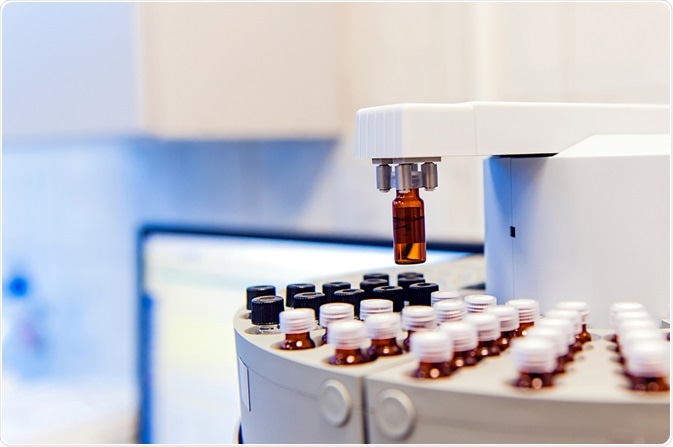Chromatography is relied on by many disciplines as a method of separating the components of a mixture. The basic idea of the process is that distinct compounds have different levels of solubility, causing them to travel through the stationary phase at different speeds, resulting in their separation as more highly soluble compounds separate faster than those with lower solubilities.

Image Credit: borzywoj/Shutterstock.com
The method has been used since the beginning of the 20th century when it was developed by Russian botanist Mikhail Semyonovich Tsvet. Since then, it has been adopted by a wide range of industries, with the list of applications of chromatography continuing to grow and evolve.
Continuing advancements in the methodology and technology used for chromatography has helped to establish the process as a standard laboratory technique across sectors, allowing it to remain relevant and useful, meeting analytical demands in a range of scientific scenarios.
Below, we discuss the recent developments in chromatography that is helping to continue to move the method forward.
Pharmaceutical analysis
The pharmaceutical industry is heavily regulated due to the necessity of ensuring the safety and efficacy of its products. The sector has relied on chromatography for decades to reliably measure the levels of impurities and degradation products within active pharmaceutical ingredients (APIs) to determine their safety and meet the specific guidelines implemented by authorities worldwide.
All areas in the pharmaceutical industry, from research through to drug development and quality control use chromatography to assess the chemical purity of the products being developed.
Currently, the gold standard of pharmaceutical analysis is reversed-phase liquid chromatography (RPLC). However, as costs of drug development have risen, and the complexity of the drug discovery process has increased in recent years, the pharmaceutical industry has demanded better performance from RPLC methods, both in terms of throughput and resolution.
In response, ultrahigh performance/pressure liquid chromatography (UHPLC) was developed. This updated technique allows for higher levels of efficiency and increased throughput in comparison with conventional chromatography methods.
Since the development of UHPLC, chromatography methods have seen further advancements as a result of pressures from the pharmaceutical industry. Recent years have seen a boom in research into protein biopharmaceuticals, such as monoclonal antibodies. These novel classes of biomolecules have specific analytical needs, which have forced the evolution of chromatography methods to meet these needs.
Recently, several innovative chromatographic columns have emerged onto the market, primarily for applications in the pharmaceutical industry, such as analysis of protein biopharmaceuticals and chiral drugs, as well as detecting genotoxic impurities.

Image Credit: Fahroni/Shutterstock.com
Forensics
Forensic science relies on chromatography techniques for the identification and measurement of illicit drugs in several sample types, such as biological fluids and tissues, as well as synthetic samples. To improve the accuracy and efficiency of methods used in forensic analysis, there have been many recent developments in methodologies, as well as an evolution in the equipment used.
Liquid chromatography (LC) has been adopted by the forensic sector for several decades to detect and quantify drugs including amphetamines, benzodiazepines, hallucinogens, cannabinoids, opiates, cocaine, designer drugs, and pharmaceutical drugs.
Recently, UHPLC has been developed to improve on LC methods (discussed above), and in forensic science, it is being used in combination with tandem mass spectrometry to improve the accuracy and resolution of the technique. The resultant UHPLC-MS/MS method operates in selected reaction monitoring mode to recognize the individual ion transition ratios of each specific analyte.
Additionally, high-resolution liquid chromatography-mass spectrometry (LC-MS) has been developed to enhance the power of traditional HRMS, allowing scientists to analyze complex matrices, and reduce the number of interferences the are commonplace in analyzing biological samples.
Metabolomics
Scientists are interested in studying the metabolome as it offers a way to measure the cell response to internal or external stimuli, allowing us to grow our knowledge of human biology at the cell level. The discipline of metabolomics has been particularly useful in the field of pharmacology, as it allows researchers to understand the impact of drugs at the cellular level.
For many years, mass spectrometry has been the most widely used analytics platform within the field of metabolomics. However, recently, the method has been coupled with LC or gas chromatography (GC) to enhance the technique’s sensitivity and resolution to the metabolites in a sample.
Innovations in the equipment used in LC as well as advancements in column chemistries have led to an enhanced method of LC-MS, allowing for wider coverage of the metabolome. Additionally, GC-MS has recently benefitted from developments in column stationary phases (SPs), which has increased the number of metabolites that are detectable by GC-MS.
Future developments in chromatography
Chromatography has been a well-established technique in laboratories across industries for several decades.
Recent developments have been fueled by the demands of the sectors that most heavily rely on the method, such as pharmaceuticals, forensics, and metabolomics. The evolving needs of these key industries will likely continue to fuel developments in chromatography.
Sources:
- D’Atri, V., Fekete, S., Clarke, A., Veuthey, J., and Guillarme, D., 2018. Recent Advances in Chromatography for Pharmaceutical Analysis. Analytical Chemistry, 91(1), pp.210-239. https://pubs.acs.org/doi/10.1021/acs.analchem.8b05026
- Jeon, J., Yang, J., Park, J., Han, N., Lee, Y. and Lee, H., 2018. Development of an automated high-throughput sample preparation protocol for LC-MS/MS analysis of glycated peptides. Journal of Chromatography B, 1092, pp.88-94. https://pubmed.ncbi.nlm.nih.gov/29885514/
- Haggarty, J., and Burgess, K., 2017. Recent advances in liquid and gas chromatography methodology for extending coverage of the metabolome. Current Opinion in Biotechnology, 43, pp.77-85. https://www.sciencedirect.com/science/article/pii/S0958166916301926
- Mogollón, N., Quiroz-Moreno, C., Prata, P., de Almeida, J., Cevallos, A., Torres-Guiérrez, R., and Augusto, F., 2018. New Advances in Toxicological Forensic Analysis Using Mass Spectrometry Techniques. Journal of Analytical Methods in Chemistry, 2018, pp.1-17. https://www.hindawi.com/journals/jamc/2018/4142527/
- Rathore, A., Kumar, D., and Kateja, N., 2018. Recent developments in chromatographic purification of biopharmaceuticals. Biotechnology Letters, 40(6), pp.895-905. https://link.springer.com/article/10.1007/s10529-018-2552-1
Further Reading
Last Updated: Oct 22, 2020